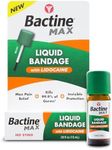Buying Guide for the Best Liquid Bandages
Choosing the right liquid bandage can be crucial for effectively treating minor cuts, scrapes, and wounds. Liquid bandages are a convenient alternative to traditional bandages, providing a protective barrier that helps to keep out dirt and germs while allowing the wound to heal. When selecting a liquid bandage, it's important to consider several key specifications to ensure you get the best product for your needs.Drying TimeDrying time refers to how quickly the liquid bandage sets and forms a protective layer over the wound. This is important because a faster drying time means you can resume your activities sooner without worrying about the bandage smudging or coming off. Drying times can range from a few seconds to a couple of minutes. If you need a quick solution, look for a product with a shorter drying time. However, if you are treating a larger area or need more precision, a slightly longer drying time might be more manageable.
Water ResistanceWater resistance indicates how well the liquid bandage can withstand exposure to water. This is crucial if you plan to wash your hands frequently, swim, or engage in activities where the bandage might get wet. Liquid bandages with high water resistance will stay intact and continue to protect the wound even when exposed to moisture. If you have an active lifestyle or need the bandage to last through showers and handwashing, opt for a highly water-resistant product.
Antibacterial PropertiesSome liquid bandages come with added antibacterial properties to help prevent infection. This is particularly important for wounds that are more prone to getting dirty or if you are in an environment where the risk of infection is higher. Antibacterial liquid bandages can provide an extra layer of protection by killing or inhibiting the growth of bacteria. If you are treating a wound that is at higher risk of infection, choosing a product with antibacterial properties is advisable.
Flexibility and DurabilityFlexibility and durability refer to how well the liquid bandage moves with your skin and how long it lasts before needing reapplication. A flexible bandage will be more comfortable and less likely to crack or peel off, especially if applied to joints or areas that move a lot. Durability ensures that the bandage remains effective for an extended period. If you need a bandage for a highly mobile area or want it to last longer, look for products that emphasize flexibility and durability.
Ease of ApplicationEase of application is about how simple and straightforward it is to apply the liquid bandage. Some products come with applicator brushes, sprays, or squeeze bottles, making them easier to use. This is important for ensuring that the bandage is applied evenly and effectively. If you are not very experienced with liquid bandages or need to apply it quickly, choose a product that offers a user-friendly application method.
IngredientsThe ingredients in a liquid bandage can affect its performance and suitability for different skin types. Some people may have sensitivities or allergies to certain ingredients, so it's important to check the label. Look for products that are hypoallergenic if you have sensitive skin. Additionally, some ingredients may offer extra benefits, such as soothing agents or vitamins that promote healing. Choose a product with ingredients that align with your skin's needs and any specific healing requirements you might have.

















